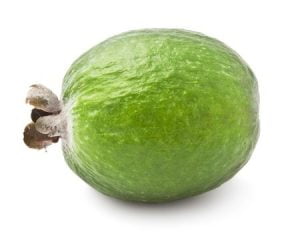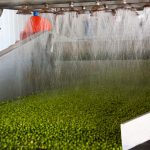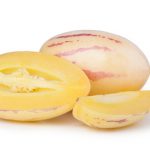
The flavour of the Feijoa fruit has been hailed as pure heaven — I have no attributable sources to this comment, save I heard it from buyers at a recent fruit symposium! The Feijoa tree shrub (Feijoa sellowiana Berg, family: Myrtaceae, synonym, Acca sellowiana) is found in the mountainous areas of southern Brazil, Argentina, west Paraguay and Uruguay growing as an evergreen bush with attractive white and red flowers. It is also grown extensively in New Zealand and Turkey as a commercial crop, and generally around the world where it serves as an ornamental in colder climates. The climate preferred by the Fejioa tree is mostly mild summers and cool winters which encourages it to bear fruit. The fruit forms in autumn and is a small oval shape of dull yellow and green which appears similar to guava.
Description Of The Plant
Fejioa is an evergreen tree which branches a great deal. It grows from 1 to 5 meters high, having reddish grey bark and a cylindrical trunk which appears to be rough and flaky. The tree bears elliptical to ovate leaves which are shortly petiolate, and opposite each other, having an entire margin and obtuse apex which is rounded at its base. The leaves measure 3 to 8 cm long, 2 to 4 cm wide. Upper surface is glossy and dark green and lower surface is tomentose and silvery white.
The tree bears attractive flowers in a pinkish red color. Flowers are solitary in lowest two or four leaf axils and measures 3 to 4 cm across. Petals are broad elliptic to spoon shaped, reflexed and whitish having red center. There are numerous stamens measuring 2.5 cm long having yellow anthers. Flowers are then replaced by oblong to ovoid fruit measuring 5 to 8 cm by 3 to 6 cm diameter. The texture of the skin differs from smooth to rough enclosing a thick and white, sweet to sub-acid flesh. The translucent pulp is enclosed with numerous small seeds in oblong shape.
Flavour
The fruit flavour is highly characteristic and described as somewhere between pineapple and passion fruit but is invariably called the ‘pineapple guava’. It is used in a variety of fruit derived applications and formats – powders, paste, jam and liqueur. Its nutritional value is to possess essential amino-acids, a vitamin C content of 28mg/100g fresh fruit and a low fat content around 0.2 to 0.8%. It also contains iodine to 3mg/100g (Basile et al., 1997).
Componentry
The volatile composition has been described with methyl and ethyl benzoate making up 9/10ths of the composition and the remainder being a mix of esters of butanoate, cinnamate and anisate amongst others (Hardy and Michael, 1970; Shaw et al., 1983; Binder and Flath, 1989; Zhang et al., 2011).
A recent article identified 19 aroma active compounds. The researchers used Solvent-Assisted Flavour Evaporation (SAFE). The odorants were identified using gas chromatogrpahy-olfactometry (GC-O) and aroma extract flavour dilution (AEDA) (Leon et al., 2020).

Componentry include tannins, napthoquinones, catechins and polyphenols and a number of bioactive products have been extensively reviewed by Weston (2010) for Industrial Research Ltd., NZ. An extract of the fruit was claimed to be active against both Gram-positive and negative bacteria in a broth dilution test using human whole blood leukocytes and neutrophils. The organisms Pseudomonas aeruginosa, Enterobacter aerogenes and Enterobacter cloacae were most susceptible (Vuotto et al., 2000). Further studies on acetone extracts also support its wide ranging antimicrobial properties, especially against Helicobacter pylori (Basile et al., 1997).
The fruit’s high value status would lend well to pulping and juice extraction. It appears to be prone to rapid browning and loss of its delicate aroma. A treatment combining the novel process technology of high hydrostatic pressure with dense phase carbon dioxide (DPCD) to carbonate the puree has been tested to denature key spoilage enzymes such as pectin methylesterase (PME), peroxidase (POD) and polyphenol oxidase (PPO) (Ortuño et al., 2013). The more severe the treatment combination, the better the loss of enzyme activity. Adding headspace carbon dioxide improved deactivation further. The byproducts from Feijoa waste are also attracting interest as a source of fibre, polyphenols, vitamins and carotenoids (Sun-Waterhouse et al., 2012).
References
Basile, A., Vuotto, M.L., Violante, U., Sorb, S., Martone, G., Castaldo-Cobianchi, R. (1997) Antibacterial activity in Actinidia chinensis, Feijoa sellowiana and Aberia caffra. Int. J. Antimicrob. Agents. 8(3) pp. 199-203
Binder, R.G.; Flath, R.A. (1989) Volatile components of pineapple guava. J. Agric. Food Chem. 37, pp. 734–736
Hardy, P.J.; Michael, B.J. (1970) Volatile components of feijoa fruits. Phytochemistry 9, pp. 1355–1357
León, D. C. S., Ortíz, D. K. R., & González, D. F. J. (2020). Sensory approach and chiral analysis for determination of odour active compounds from feijoa (Acca sellowiana). Food Chemistry, 317, 126383 (Article).
Ortuño, C., Duong, T., Balaban, M. Benedito, J.(2013) Combined High Hydrostatic Pressure and Carbon Dioxide Inactivation of Pectin Methylesterase, Polyphenol Oxidase and Peroxidase in Feijoa Puree. J. Supercritical Fluids (2013).
Shaw, G.J.; Ellingham, P.J.; Birch, E.J. (1983) Volatile constituents of feijoa-headspace analysis of intact fruit. J. Sci. Food Agr. 34, pp. 743–747.
Sun-waterhouse, D., Wang, W., Waterhouse, GIN.,Wadhwa, S.S. (2012) Utilisation Potential of Feijoa Fruit wastes as Ingredients for Functional Foods. Food Bioproc. Technol. DOI 10.1007/s11947-012-0978-3
Vuotto, M.L., Basile, A., Moscatiello, V., de Sole, P., Castaldo-Cobianchi, R. Laghi, E. Lelpo, M.T.L. (2000) Antimicrobial and Antioxidant Activities of Feijoa sellowiana fruit. Int. J. Antimicrob. Agents. 13(3) pp. 197-201
Weston, R.J. (2010) Bioactive products from fruit of the feijoa 9Feijoa sellowiana, Myrtaceae): A Review. Food Chem., 121(4) pp. 923-926
Zhang, M., Wang, D., Ren, S-X., Peng, L. (2011) Head-Space Solid Phase Microextraction and GC-MS Anal;ysis of aroma Compounds In Feijoa sellowiana In: Bioinformatics and Biomedical Engineering, (iCBBE) 5th Int. Conf.10-12th May, Wuhan. ISBN 978-1-4244-5088-6



Leave a Reply